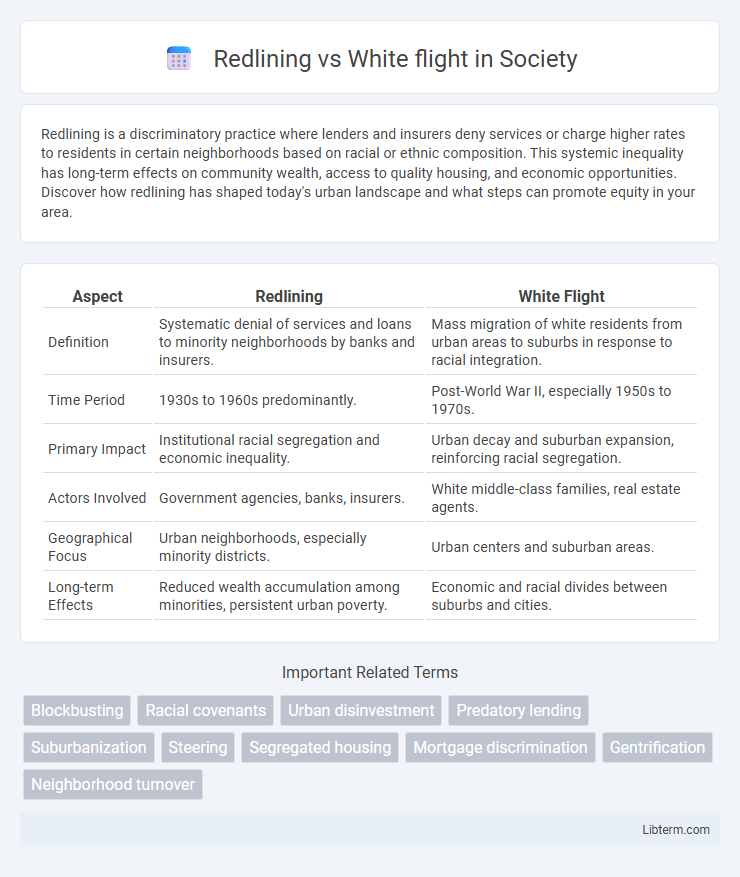Redlining is a discriminatory practice where lenders and insurers deny services or charge higher rates to residents in certain neighborhoods based on racial or ethnic composition. This systemic inequality has long-term effects on community wealth, access to quality housing, and economic opportunities. Discover how redlining has shaped today's urban landscape and what steps can promote equity in your area.
Table of Comparison
| Aspect | Redlining | White Flight |
|---|---|---|
| Definition | Systematic denial of services and loans to minority neighborhoods by banks and insurers. | Mass migration of white residents from urban areas to suburbs in response to racial integration. |
| Time Period | 1930s to 1960s predominantly. | Post-World War II, especially 1950s to 1970s. |
| Primary Impact | Institutional racial segregation and economic inequality. | Urban decay and suburban expansion, reinforcing racial segregation. |
| Actors Involved | Government agencies, banks, insurers. | White middle-class families, real estate agents. |
| Geographical Focus | Urban neighborhoods, especially minority districts. | Urban centers and suburban areas. |
| Long-term Effects | Reduced wealth accumulation among minorities, persistent urban poverty. | Economic and racial divides between suburbs and cities. |
Understanding Redlining: Origins and Practices
Redlining originated in the 1930s when the Home Owners' Loan Corporation (HOLC) created color-coded maps to assess mortgage lending risks, systematically marking minority neighborhoods in red as hazardous. This institutionalized racial discrimination restricted African American and minority families from accessing home loans and investing in their communities, contributing to economic disparity. The practice reinforced segregation by denying essential financial services based on race, laying a foundation for persistent urban inequality.
White Flight: Definition and Historical Context
White flight refers to the mass migration of white residents from urban centers to suburban areas, primarily occurring in the mid-20th century United States. This demographic shift was driven by racial tensions, economic changes, and policies such as the construction of highways and suburban housing developments. The exodus significantly contributed to urban decline, segregated neighborhoods, and persistent socio-economic disparities between cities and suburbs.
How Redlining Fueled Residential Segregation
Redlining, a discriminatory practice where banks and insurers denied services to residents in predominantly Black neighborhoods, directly fueled residential segregation by restricting access to mortgages and investment in these areas. This institutionalized disinvestment led to deteriorating infrastructure and reduced economic opportunities, reinforcing racial divides. The systemic barriers imposed by redlining created segregated urban landscapes that persisted as White flight accelerated, with White families moving to suburban areas to avoid declining neighborhoods.
The Economic Impact of White Flight on Urban Centers
White flight led to significant economic decline in urban centers as the departure of middle-class and affluent white residents eroded the tax base, reducing funding for public services and infrastructure. This outmigration caused property values to plummet and discouraged investment, intensifying economic disparities and urban decay. The resulting fiscal crisis limited cities' ability to maintain schools, transportation, and public safety, deepening cycles of poverty and segregation.
Comparing Redlining and White Flight: Key Differences
Redlining refers to the systematic denial of services and investments in predominantly minority neighborhoods through racially discriminatory lending practices, while white flight describes the mass migration of white residents from urban areas to suburbs in response to racial integration. Redlining enforces segregation by limiting economic and housing opportunities for minorities, whereas white flight results in demographic shifts that further entrench racial segregation and economic disparities. Both phenomena contributed to the spatial inequality and socio-economic divide in American cities, with redlining institutionalizing discrimination and white flight altering urban population dynamics.
Shared Consequences: Decline in Community Resources
Redlining and white flight both contributed significantly to the decline in community resources by reducing investment in predominantly minority neighborhoods and causing population shifts to suburban areas. These practices resulted in underfunded schools, deteriorating infrastructure, and limited access to healthcare and businesses, further entrenching economic disparities. The combined effect weakened the social fabric and economic vitality of urban communities, perpetuating cycles of poverty and segregation.
Government Policies and Their Role in Segregation
Government policies such as redlining institutionalized segregation by denying minority communities access to mortgages and loans, reinforcing economic disparities. White flight was accelerated as these policies incentivized white residents to move to suburban areas with better-funded schools and services, further entrenching segregation. Together, redlining and white flight shaped urban demographics and perpetuated systemic inequality through deliberate policy decisions and zoning laws.
Lasting Effects on Modern Neighborhoods
Redlining systematically denied minority communities access to home loans, creating persistent racial and economic segregation that limits generational wealth accumulation. White flight exacerbated neighborhood disinvestment as middle-class white families moved to suburbs, resulting in urban decline and reduced public services in minority-dominated areas. These combined policies contribute to stark disparities in property values, educational opportunities, and healthcare access that continue to shape modern urban landscapes.
Anti-Discrimination Laws and Their Effectiveness
Anti-discrimination laws such as the Fair Housing Act of 1968 aimed to combat redlining by prohibiting racial discrimination in housing and lending practices, though enforcement challenges limited immediate impact. Despite legal protections, white flight persisted as many white families moved to suburban areas to avoid integration, highlighting the laws' limitations in addressing socio-economic and racial segregation. Ongoing efforts to enhance enforcement and promote inclusive housing policies have gradually improved access to diverse neighborhoods, yet disparities rooted in historical redlining continue to shape urban demographics.
Pathways Toward Equitable Urban Development
Redlining, a discriminatory lending practice that denied mortgages to predominantly Black neighborhoods, entrenched racial segregation and economic disparities in urban areas. White flight, the mass exodus of white residents from these neighborhoods to suburbs, further depleted resources and investment in inner cities, worsening inequality. Pathways toward equitable urban development must prioritize dismantling these historical barriers through targeted investment, inclusive housing policies, and community-driven planning to foster integrated, resilient neighborhoods.
Redlining Infographic

 libterm.com
libterm.com